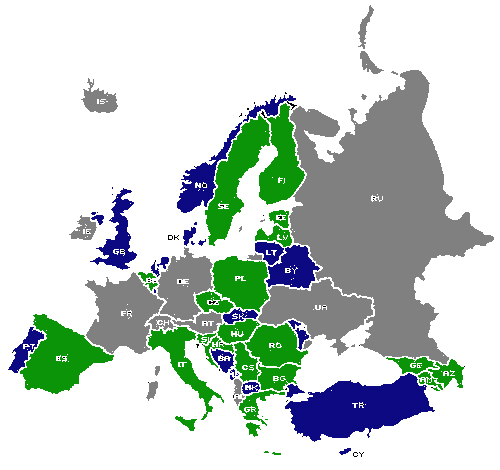Report on the BME education status in Europe and future trends
Activities
1.1 Review of the existing BME programs at EU and Partner countries
1.2 Study of the recent developments and future trends in the medical industry market
Review of the existing educational programs in Biomedical Engineering at European Union and Partner Countries
For the purposes of the project 46 countries in Europe and neighbourhood area were investigated. The project consortium consists of 23 partners distributed in 20 different countries. Each project partner provided information for the BME programs in his own country, and thus initially 20 countries were covered from the project consortium. From the remaining 30 countries, there were other 15 countries that were identified as possible to be covered from the some project partners. Finally, 11 other countries remained, and the information concerning the BME programs was provided from Internet resources only.
Visual representation of the countries’ coverage concerning the BME programs.

![]() – Country with a partner from the project consortium
– Country with a partner from the project consortium
![]() – Country covered by a partner from the project consortium
– Country covered by a partner from the project consortium
![]() – Country covered by Internet resource only
– Country covered by Internet resource only
The present study identified that Biomedical Engineering programs are existing in 40 countries. Approximately 150 Universities across Europe offer in total 298 BME programs, distributed as following: 82 Undergraduate programs offering BSc degree, and 216 Postgraduate programs, from which 156 offer MSc degree and 60 offer PhD degree. In percentage ratios the numbers are: 28 % BSc, 52 % MSc, 20% PhD.
More than 90 % of BME programs have the elaboration of a thesis obligatory. More than 85 % of BME programs are only full time teaching, and less than 15 % have options for part-time teaching or e-learning.
Related to the student exchange and mobility, approximately 90 % of the BME programs apply the European Credit Transfer and Accumulation System (ECTS). Approximately, 75 % of the BME programs accept foreign students, and 70 % of the BME programs have bilateral agreements with other universities.
Concerning the age of the BME programs, only 15% of the programs were existing 20 years ago, while the 2/3 have been created after year 2000.



